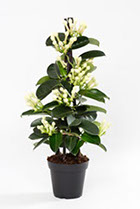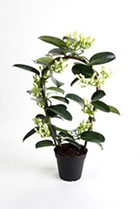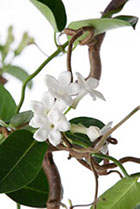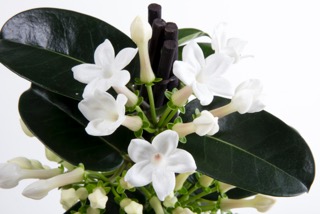


STEPHANOTIS FLORIBUNDA
(MADAGASCAR JASMINE)
HISTORY:
Stephanotis floribunda was first described in 1837 by the French botanist Adolphe-Thédore Brongniart (1801–1876). The first plants were shown in England already seven years after Brongniart’s description. Stephanotis was discovered in the rainforests on the east side of Madagascar. It is a splendid potted plant and provides years of enjoyment. We sell it to countries such as Denmark, Sweden, Norway, France, the UK, Italy, Austria, Switzerland and Germany and have also delivered it to various royal families, including in Denmark, Norway and the UK. Stephanotis floribunda is ideal for beautiful flower arrangements and bridal bouquets and was included in the bridal bouquets of HM Queen Margrethe and HRH Crown Princess Mary, for instance.
BOTANICAL FACTS:
The name Stephanotis comes from the Greek word stephanos (crown) and otis (ear), which refers to the flower’s appearance. Floribunda means “flowery” or “full of flowers”. It is a climber with dark-green, shiny and leathery leaves. The stem is herbaceous for about a year, after which it becomes woody. Stephanotis can reach lengths of up to 25 metres in a rainforest, but at our nursery it is allowed to become between 2 and 2.5 metres long. It takes lots of work and dexterity to cultivate Stephanotis floribunda and about one year to cultivate the approximately two-metre-long vines that are tied up on a nature hoop or nature pyramid. The plants are available in various grades, depending on the number of flower clusters. Each year for the past fifty years we have selected the best plants as parent plants. We give them plenty of time to grow, which is why our Stephanotis floribunda has lovely, lush leaves and fragrant flower clusters.
CARE:
Do not let the plant dry out during the flowering phase. Once the plant loses all its flowers, it is fine if it dries out between waterings. If you give it ordinary floral fertiliser about once a week, you will experience an additional flowering phase. During flowering, the plants cannot withstand draughts, and it is recommended that you do not place it in direct sunlight. In summer, it thrives nicely outdoors if it is somewhat protected. If it is kept in a cool location during the flowering phase, the flowers will last longer. The plant cannot withstand frost, however, and temperatures below 14⁰ C are not recommended. Stephanotis floribunda is a “long-day plant”, which means that it naturally forms flowers when the day is longer than the night. Therefore, it will naturally form flowers in late spring and in the summer.
FLOWERS:
Flower buds always develop on new shoots where they “hibernate” and wait for ideal light and temperatures. Shoots also form in leaf corners.

FRUITS:
If you want Stephanotis floribunda seeds, you must leave the flowers on the plant. If fruit forms, the flower stem will remain green and a fruit will form on the stem. The fruit resembles a large green plum and is not edible. If the flower stem turns yellow and the flower falls off the plant by itself, no fruit will form. It usually takes more than a year for any fruit to ripen. When this happens, it turns brown and opens. The seeds can be sown at room temperature in fine peat moss. At first, the new plant will not resemble the old one, as it is in its juvenile phase, with narrower, thinner leaves and dark-red veins, for instance. It takes about four years for the plant to reach its mature phase and resemble the Stephanotis floribunda we know and which can form flowers.




